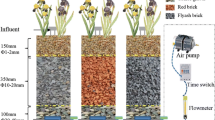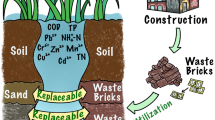Abstract
Adopting the concept of "using waste to treat waste", the waste bricks will be used for constructed wetland filling. Integrated vertical-flow constructed wetland (IVCW) studied on the purification effect in influent water under three hydraulic loads (0.15, 0.25, 0.35 m/day). The results show that the waste bricks can be used as the carrier for the growth of the system biofilm, and have positive effects on the removal of pollutants in the influent water. Under three different hydraulic load conditions, the vertical flow of CWs can significantly reduce the load of water intake. In the low hydraulic load condition of 0.15 m/day, the average removal rates of chemical oxygen demand (COD), ammonia nitrogen (NH3-N), total nitrogen (TN), and total phosphorus (TP) can reach 66.52%, 72.10%, 56.53% and 91.55% in this system, respectively. The influent pool on removal efficiency of pollutants was obviously higher than that of the upper pool, especially in the inlet surface 0–30 cm ranges. This research has achieved the effect of using "waste" to treat wastewater, which has strong practical significance and popularization value.










Similar content being viewed by others
Explore related subjects
Discover the latest articles and news from researchers in related subjects, suggested using machine learning.References
Abou-Elela SI, Fawzy ME, El-Gendy AS (2015) Potential of using biological aerated filter as a post treatment for municipal wastewater. Ecol Eng 84:53–57
Ahmed G, Latifa B, Fabio M, Martin R (2011) Constructed wetland as a low cost and sustainable solution for wastewater treatment adapted to rural settlements: the Chorfech wastewater treatment pilot plant. Water Sci Technol A 63:3006
An W, Zhou X, Liu X, Chai PW, Kuznicki T, Kuznicki SM (2014) Natural zeolite clinoptilolite-phosphate composite Membranes for water desalination by pervaporation. J Membr Sci 470:431–438
Bao Z, Lu W, Chi B, Yuan H, Hao J (2019) Procurement innovation for a circular economy of construction and demolition waste: lessons learnt from Suzhou, China. Waste Manag 99:12–21
Braskerud CB, Lundekvam H, Krogstad T (2000) The impact of hydraulic load and aggregation on sedimentation of soil particles in small constructed wetlands. J Environ Qual 29:2013–2020
Chen ZM, Chen B, Zhou JB, Li Z, Zhou Y, Xi XR, Lin C, Chen GQ (2008) A vertical subsurface-flow constructed wetland in Beijing. Commun Nonlinear Sci Numer Simul 13:1986–1997
Chen J, Yao J, Bai YL (2009) Rural domestic wastewater treatment through anaerobism and artificial wetland. Agric Sci Technol (Engl). 10:158–161
Cui B, Yang Q, Zhang Y, Liu X, Wu W, Li J (2019) Improving nitrogen removal in biological aeration filter for domestic sewage treatment via adjusting microbial community structure. Bioresour Technol 293:122006
Dong QZ, Jinadasa KBSN, Gersberg RM, Yu L, Ng WJ, Tan SK (2014) Application of constructed wetlands for wastewater treatment in developing countries: a review of recent developments (2000–2013). J Environ Manag 141:116–131
Feng L, Yang G, Zhu L, Xu X, Gao F, Mu J, Xu Y (2015) Enhancement removal of endocrine-disrupting pesticides and nitrogen removal in a biofilm reactor coupling of biodegradable Phragmites communis and elastic filler for polluted source water treatment. Bioresour Technol 187:331–337
Ghosh D, Gopal B (2010) Effect of hydraulic retention time on the treatment of secondary effluent in a subsurface flow constructed wetland. Ecol Eng 36:1044–1051
Hamid KIA, Sanciolo P, Gray S, Duke M, Muthukumaran S (2019) Comparison of the effects of ozone, biological activated carbon (BAC) filtration and combined ozone-BAC pre-treatments on the microfiltration of secondary effluent. Sep Purif Technol 215:308–316
Ivanov I, Ren L, Siegert M, Logan BE (2013) A quantitative method to evaluate microbial electrolysis cell effectiveness for energy recovery and wastewater treatment. Int J Hydrogen Energy 38:13135–13142
Ji ZH, Feng CL, Wu XF, Zhou SY, Huang HM (2016) Research progress on filler application and purification mechanisms in constructed wetland wastewater treatment system. Chin J Ecol 8:35
Lantzke IR, Mitchell DS, Heritage AD, Sharma KP (1999) A model of factors controlling orthophosphate removal in planted vertical flow wetlands. Ecol Eng 12:93–105
Liu R, Zhao Y, Doherty L, Hu Y, Hao X (2015) A review of incorporation of constructed wetland with other treatment processes. Chem Eng J 279:220–230
Lu S, Pei L, Bai X (2015) Study on method of domestic wastewater treatment through new-type multi-layer artificial wetland. Int J Hydrogen Energy 40:11207–11214
Lu D, Chen Q, Liu P, Xia Z, Wang H, Zhou Q, Dong X, Wu Z (2017) Phosphorus removal performance and biological dephosphorization process in treating reclaimed water by Integrated Vertical-flow Constructed Wetlands (IVCWs). Bioresour Technol 243:204–211
Mohan SV, Mohanakrishna G, Ramanaiah SV, Sarma PN (2008) Simultaneous biohydrogen production and wastewater treatment in biofilm configured anaerobic periodic discontinuous batch reactor using distillery wastewater. Int J Hydrogen Energy 33:550–558
Monitor PASE (2002) Monitor and analysis method of water and wastewater. Chinese Environmental Science Publication House, Beijing
Rousseau DPL, Vanrolleghem PA, Pauw ND (2004) Model-based design of horizontal subsurface flow constructed treatment wetlands: a review. Water Res 38:1484–1493
Sbardella L, Comas J, Fenu A, Rodriguez-Roda I, Weemaes M (2018) Advanced biological activated carbon filter for removing pharmaceutically active compounds from treated wastewater. Sci Total Environ 636:519
Shen Z, Zhou Y, Jia L, Yu X, Rong C, Wu F (2015) Enhanced removal of nitrate using starch/PCL blends as solid carbon source in a constructed wetland. Bioresour Technol 175:239–244
Shi X, Fan J, Zhang J, Shen Y (2017) Enhanced phosphorus removal in intermittently aerated constructed wetlands filled with various construction wastes. Environ Sci Pollut Res 24:1–11
Strzemiecka B, Voelkel A, Kasperkowiak M (2010) Characterization of zeolites as potential new generation fillers in abrasive articles. Physicochemical properties of zeolites and their interactions with resins. Colloids Surf A 372:80–85
Tang ZR, Wen Y, Zhou Q (2012) Research on the phosphorus removal mechanisms and approaches in various horizontal subsurface flow constructed wetlands. Adv Mater Res 573–574:599–604
Verlicchi P, Zambello E (2014) How efficient are constructed wetlands in removing pharmaceuticals from untreated and treated urban wastewaters? A review. Sci Total Environ 470–471:1281–1306
Wang Q, Xie H, Ngo HH, Guo W, Zhang J, Liu C, Liang S, Hu Z, Yang Z, Zhao C (2016) Microbial abundance and community in subsurface flow constructed wetland microcosms: role of plant presence. Environ Sci Pollut Res 23:4036–4045
Wang H-C, Cui D, Han J-L, Cheng H-Y, Liu W-Z, Peng Y-Z, Chen Z-B, Wang A-J (2019) A2O-MBR as an efficient and profitable unconventional water treatment and reuse technology: a practical study in a green building residential community. Resourc Conserv Recycl 150:104418
Weerakoon GMPR, Jinadasa KBSN, Herath GBB, Mowjood MIM, Bruggen JJAV (2013) Impact of the hydraulic loading rate on pollutants removal in tropical horizontal subsurface flow constructed wetlands. Ecol Eng 61:154–160
Wu JQ, Wang M, Wu J, Tang H (2012) Treatment of polluted river water using surface flow constructed wetlands in Xinyi River Floodplain. Adv Mater Res 396–398:1909–1913
Wu S, Kuschk P, Brix H, Vymazal J, Dong R (2014) Development of constructed wetlands inperformance intensifications for wastewater treatment: a nitrogen and organic matter targeted review. Water Res 57C:40–55
Wu H, Jian Z, Ngo HH, Guo W, Zhen H, Shuang L, Fan J, Hai L (2015) A review on the sustainability of constructed wetlands for wastewater treatment: design and operation. Bioresour Technol 175:594–601
Xu Q, Hunag Z, Wang X, Cui L (2015) Pennisetum sinese Roxb and Pennisetum purpureum Schum. as vertical-flow constructed wetland vegetation for removal of N and P from domestic sewage. Ecol Eng 83:120–124
Yang Y, Wang ZM, Liu C, Guo XC (2012) Enhanced p, n and c removal from domestic wastewater using constructed wetland employing construction solid waste (csw) as main substrate. Water Sci Technol 66(5):1022–1028
Ying-Feng L, Shuh-Ren J, Tze-Wen W, Der-Yuan L (2001) Effects of macrophytes and external carbon sources on nitrate removal from groundwater in constructed wetlands. Environ Pollut 119:413–420
Zaytsev I, Mander Ü, Lõhmus K, Nurk K (2011) Enhanced denitrification in a bioaugmented horizontal subsurface flow filter. Ecol Eng 37:1050–1057
Zhang L, Zhang L, Liu Y, Shen Y, Liu H, Xiong Y (2010) Effect of limited artificial aeration on constructed wetland treatment of domestic wastewater. Desalination 250:915–920
Zhang L, Sun Z, Jia X, Wu J, Cheng S (2018) Nutrient removal, biomass accumulation and nitrogen-transformation functional gene response to different nitrogen forms in enhanced floating treatment wetlands. Ecol Eng 112:21–25
Zhao XH, Zhao YQ, Kearney P (2011) Transformation of beneficially reused aluminium sludge to potential P and Al resource after employing as P-trapping material for wastewater treatment in constructed wetland. Chem Eng J 174:206–212
Zhao M, Wang S, Wang H, Qin P, Yang D, Sun Y, Kong F (2019) Application of sodium titanate nanofibers as constructed wetland fillers for efficient removal of heavy metal ions from wastewater. Environ Pollut 248:938–946
Zheng Y, Wang XC, Dzakpasu M, Yuan G, Zhao Y, Xiong J (2016) Performance of a pilot demonstration-scale hybrid constructed wetland system for on-site treatment of polluted urban river water in Northwestern China. Environ Sci Pollut Res 23:447–454
Zhou X, Wang X, Zhang H, Wu H (2017) Enhanced nitrogen removal of low C/N domestic wastewater using a biochar-amended aerated vertical flow constructed wetland. Bioresour Technol 241:269–275
Acknowledgements
This work was financially supported by the National Natural Science Foundation of China (Grant No. 51768031) and the Key Research and Development Program in Gansu Province (Grant No. 17YF1NA056).
Author information
Authors and Affiliations
Corresponding author
Additional information
Publisher's Note
Springer Nature remains neutral with regard to jurisdictional claims in published maps and institutional affiliations.
Rights and permissions
About this article
Cite this article
Zhang, G., Ma, K., Zhang, Z. et al. Waste Brick as Constructed Wetland Fillers to Treat the Tail Water of Sewage Treatment Plant. Bull Environ Contam Toxicol 104, 273–281 (2020). https://doi.org/10.1007/s00128-020-02782-4
Received:
Accepted:
Published:
Issue Date:
DOI: https://doi.org/10.1007/s00128-020-02782-4




